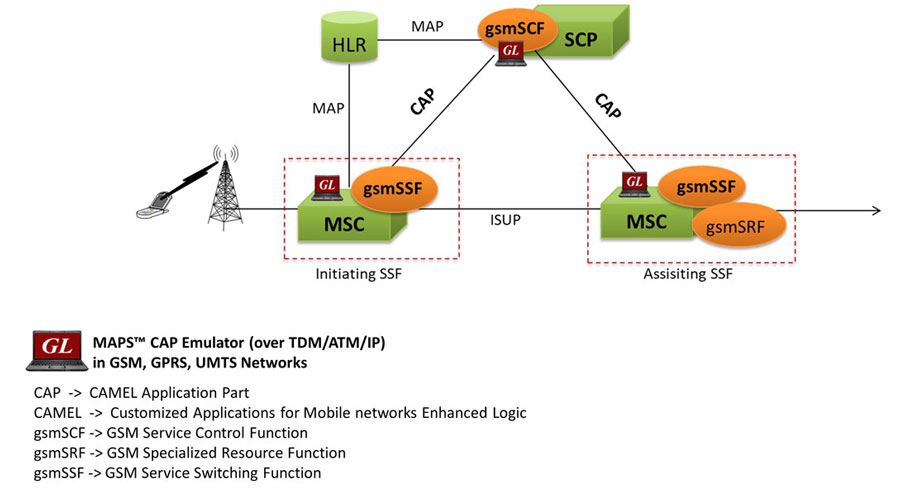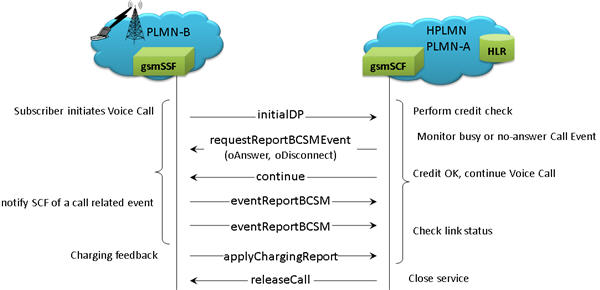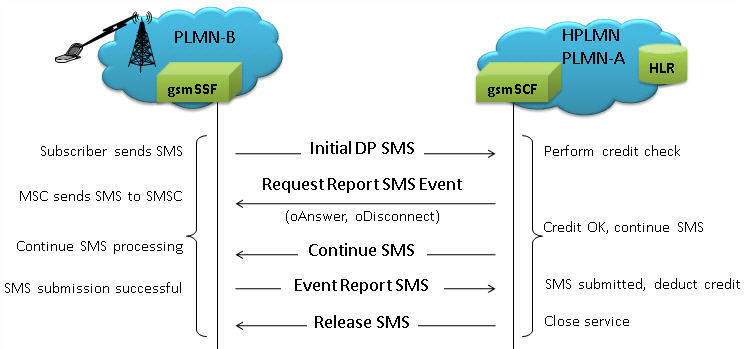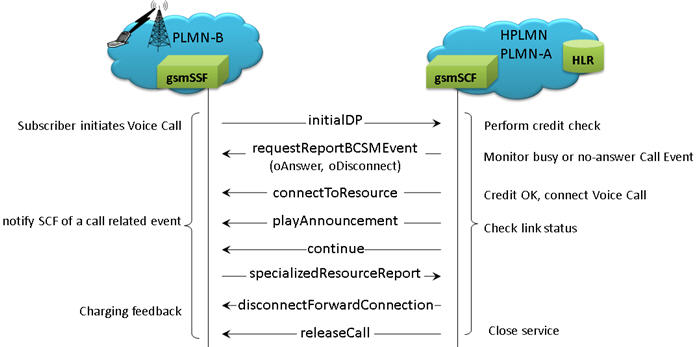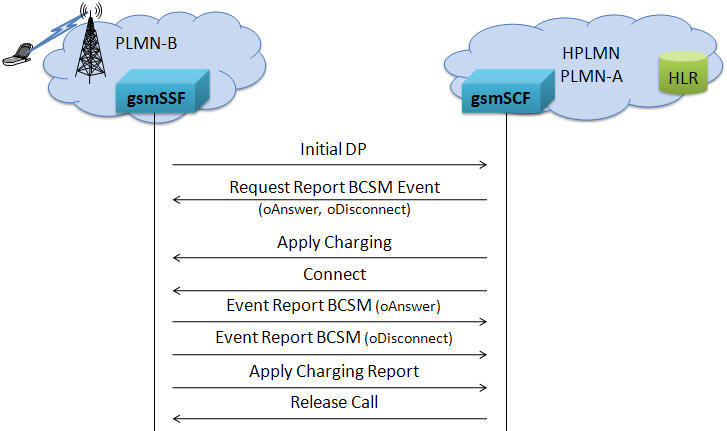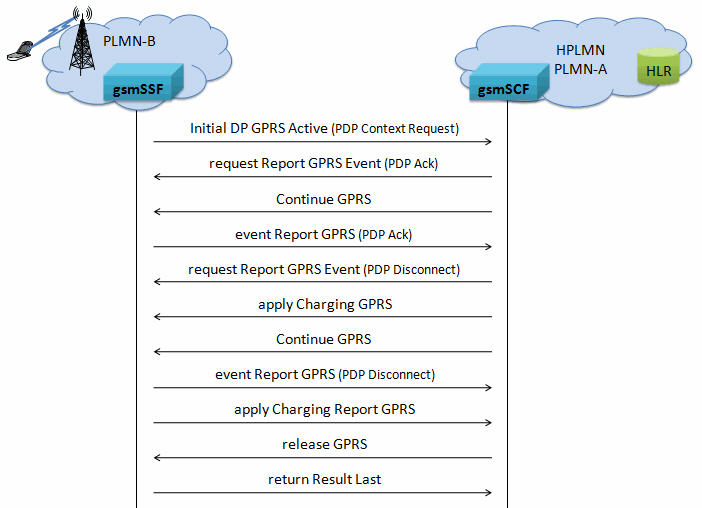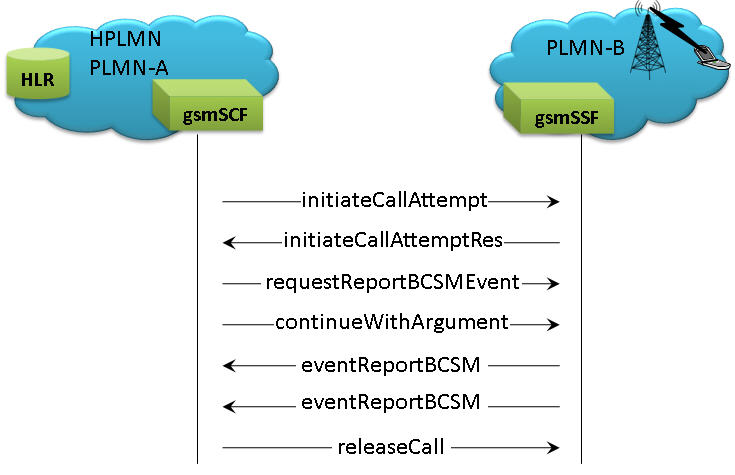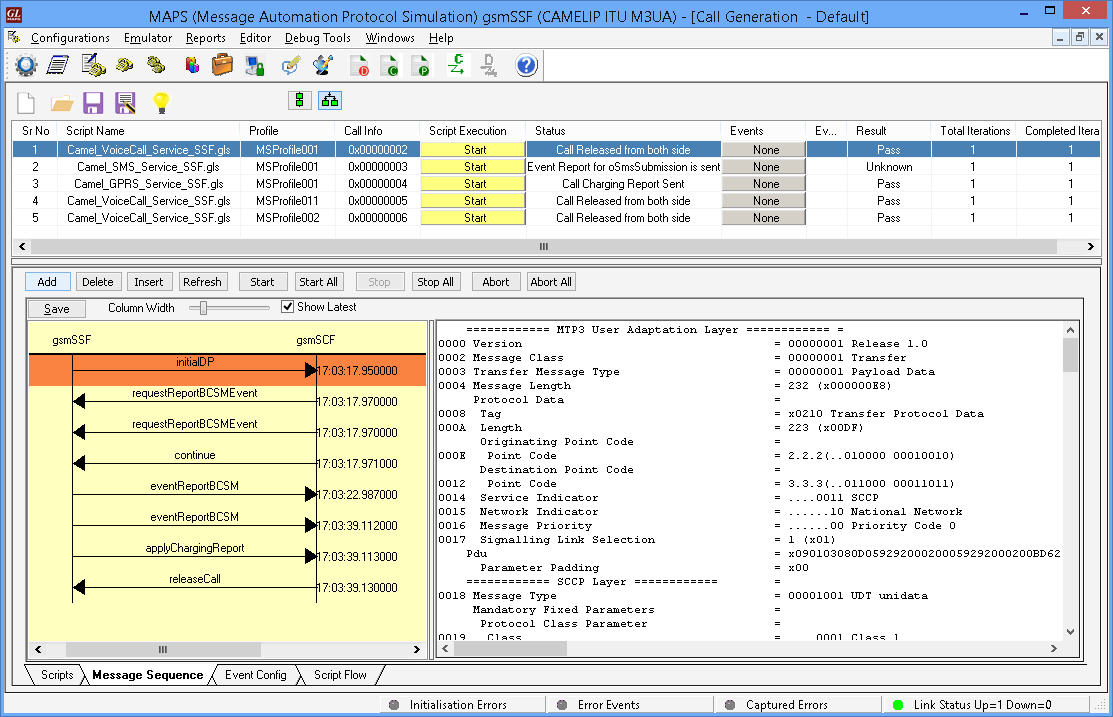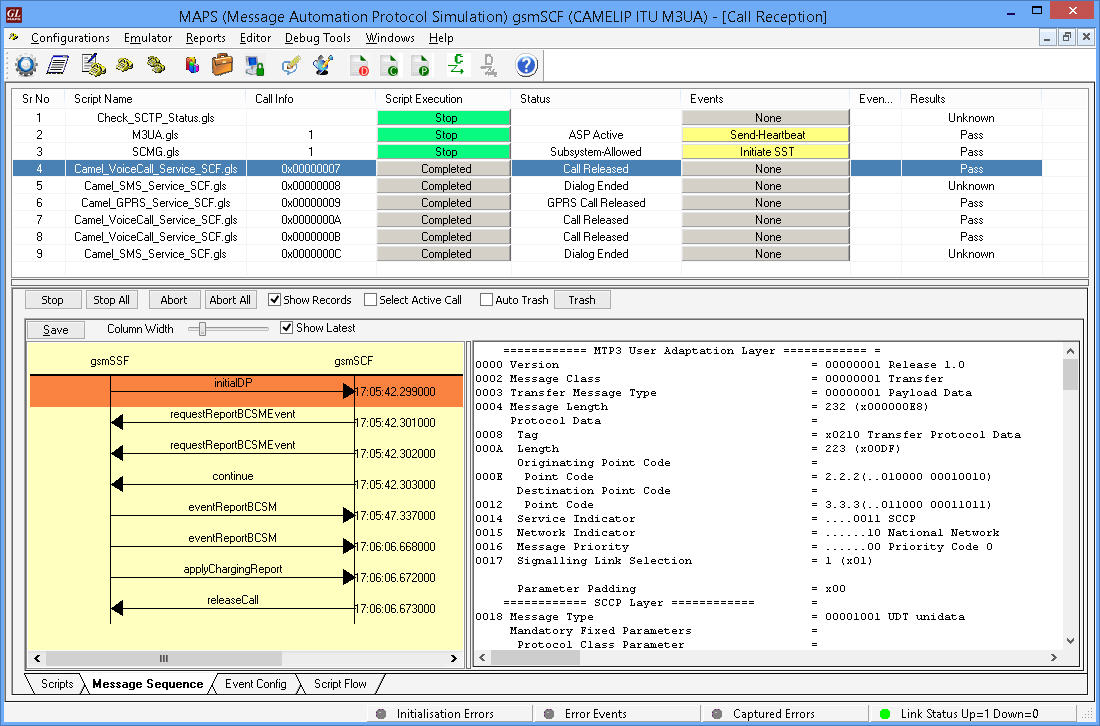MAPS™ CAP Protocol Emulator
Simulate CAP (CAMEL Application Part) supplementary services over TDM/ATM and IP between Service Control Function (SCF) and Service Switching Function (SSF) entities.
Brochure Request a Demo / QuoteBackground
Traditional telecommunications networks usually limited to making and receiving voice calls are now supporting enhanced services such as prepaid calling, tele-voting, number portability, call transfer, and so on. Such enhanced Intelligent Network (IN) services were standardized by the ITU-T standards body.
The CAMEL protocol architecture is based on the Intelligent Network (IN) standards, and uses the CAMEL Application Part (CAP) protocol.
CAMEL the IN control protocol, is used between the gsmSSF and the gsmSCF. All CAMEL service requests are directed to a gsmSCF. The gsmSCF is a functional entity where the CAMEL services reside. The node in which the gsmSCF resides is called the 'Service Control Point' (SCP).
The capability of CAMEL Application Part (CAP) is defined by means of 'operations', which means one entity, starts a procedure in the peer entity. The transfer of the CAP operations between the gsmSSF and the gsmSCF is done through the GSM, GPRS, and UMTS networks.
The IN control protocol at the exchange is handled by the Service Switching Function (SSF). The SSF passes call control from the exchange to the SCP and relays back the instructions to the exchange.
Overview
GL's Message Automation & Protocol Simulation (MAPS™) is a multi-protocol, multi-technology platform used for the emulation of a variety of communication protocols over IP, TDM, ATM and Wireless networks. MAPS™ can be used to test signaling over legacy networks (such as CAS, SS7, ISDN, PPP and more), IP networks (such as SIP, MGCP, MEGACO, SIGTRAN, Diameter…) and also the Wireless technologies including GSM, UMTS, and LTE networks. Recently, CAMEL (Customized Applications for Mobile networks Enhanced Logic) Application Part (CAP) Protocol emulation capability has been added.
GL's MAPS™ CAP Emulator (MTP2/ATM) can emulate CAP (CAMEL Application Part) supplementary services such as unified messaging, prepaid, and toll-free (Freephone). These services are available in TDM/ATM and IP based GSM, GPRS, UMTS networks. CAP information flow is defined between functional entities such as Service Control Function (SCF) and Service Switching Function (SSF) distributed across network executing services.
MAPS™ CAP functionality covers the ITU and ANSI variants of GSM, GPRS, UMTS implementing M3UA, M2PA, MTP3 and ISUP protocols over TDM/ATM and IP. CAP can be transported using 'traditional' protocols carried by Message Transfer Protocol (MTP) in TDM/ATM (T1 and E1) or over IP using SIGTRAN. With the popularity of the internet and IP, a special IP protocol called SIGTRAN is rapidly gaining acceptance to transport protocol signaling over IP.
MAPS™ CAP scripts, suitable for testing objects reliably and accurately validated for compliance with ANSI and ITU specifications. It is suitable for controlling telecommunication services such as Camel Voice Call Service – which includes Prepaid Call, Toll-free call (free phone), Low Balance Call Services (release on low balance, play announcement on low balance), Camel GPRS Service, Camel SMS Service, and Camel Initiate Call Attempt (ICA) Service.
The tester supports testing network elements SSF and SCF, error tracking, regression testing, conformance testing, and load testing/call generation. It can run pre-defined test scenarios against CAP interface test objects in a controlled & deterministic manner.
MAPS™ Emulator supports powerful utilities like Message Editor, Script Editor, and Profile Editor which allow new scenarios to be created or existing scenarios to be modified using CAP messages and parameters.
MAPS™ CAP ATM uses SSCOP server for establishing SSCOP links over which IN signaling will be carried further for making calls. SSCOP Server is GL's WCS based server module and provides SSCOP, and AAL5 layer services.
Over successfully established call, traffic can be generated. MAPS™ CAP ATM internally uses AAL5 Traffic Generator for traffic generation. Various traffic types like Tone, Digits and File playback are supported.
The AAL5 traffic simulation supports the following actions:
- Transmitting Voice Files
- Transmitting DTMF, MF Digits, and other Tones and Dual Tones
- Recording Voice Files
- Monitoring Single and Dual Tones, DTMF, and MF digits
MAPS™ supports Command Line Interface (CLI) and when configured as server-side application enables remote controlling of the application through multiple command-line based clients including Python, Java, TCL and others, using MAPS™ client-server architecture (requires additional license).
GL also provides various set of protocol analyzer for on-line capture and decode of the signaling in real-time both during tests and as a stand-alone tracer for live systems. Please visit Protocol Analysis page for more details.
Possible applications include:
- Multi-protocol, Multi-interface Simulation
- Test Service Usage Charging for Voice, Data, SMS, etc
- Cost-of-call verification through balance check
- Test Premium Calling and Toll-Free Services
- Provides fault insertion, and erroneous call flows testing capability.
- Performance testing, Load Testing, Functional testing, Regression testing and Conformance testing of network elements.
- Ready scripts make testing procedure simpler, less time consuming and hence time to market products.
- Test response of network against protocol message modification, or corruption
- Inter-operability testing of networks
Supported Protocols Standards
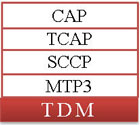 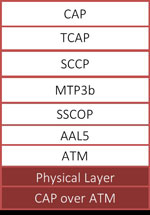 Protocol Stack TDM and ATM |
|
||||||||||||||||||||||||||||
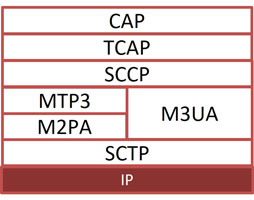 CAMEL IP Protocol Stack |
|
Typical Call Procedures
Shown below are the typical CAP procedures over IP and TDM/ATM interfaces:
CAP Procedure Generation and Reception
MAPS™ CAP is configured as gsmSSF node initiating the CAP procedures. The application can also be configured as DUT (gsmSCF) at the network terminal receiving the procedure specific request messages and responding back to the gsmSSF. All the above listed Camel services are supported in MAPS™.
Resources
Please Note: The XX in the Item No. refers to the hardware platform, listed at the bottom of the Buyer's Guide, which the software will be running on. Therefore, XX can either be ETA or EEA (Octal/Quad Boards), PTA or PEA (tProbe Units), XUT or XUE (Dual PCIe Express) depending upon the hardware.
| Item No. | MAPS™ for TDM / IP Network |
| XX696 | MAPS™ CAP Emulator |
| PKS151 | MAPS™ CAMEL IP Emulator |
| Item No. | MAPS™ for Wireless Network |
| PKS140 | MAPS™ LTE S1 Emulator |
| LTS220 | MAPS™ UMTS IuCS ATM Emulator over OC-3 / STM-1 requires LTS214 + LightSpeed1000™ Hardware; optional LTS217 |
| LTS214 | OC-3 / STM-1 SSCOP Server |
| LTS320 | MAPS™ UMTS IuCS ATM Emulator over OC-12 / STM-4 requires LTS314 + LightSpeed1000™ Hardware; optional LTS317 |
| Related Hardware | |
|---|---|
| LTS100 | Lightspeed1000™ - Dual OC-3/12 STM-1/4 PCIe Card (Legacy) |
| Item No. | MAPS™ for IP Network |
| XX694 | MAPS™ MAP Emulator |
| XX696 | MAPS™ CAP Emulator |
| XX656 | MAPS™ INAP Emulator |
| XX624 | MAPS™ FXO FXS Emulator (only for tProbe) |
| Related Hardware | |
| FTE001 ETE001 |
QuadXpress T1E1 Main Board (Quad Port– requires additional licenses) OctalXpress T1E1 Main Board plus Daughter Board (Octal Port– requires additional licenses) |
| PTE001 | tProbe™ Dual T1 E1 Laptop Analyzer with Basic Analyzer Software |
| XTE001 |
Dual T1 E1 Express (PCIe) Boards (requires additional licenses) |
| Item No. | Traffic Options |
| GTP Mobile Traffic Options | |
| ETH101 ETH102 ETH103 |
MobileTrafficCore - GTP MobileTrafficCore - Gateway MobileTrafficCore for Gb Interface |
| TDM Traffic Options | |
| XX610 XX620 XX646 |
File based Record/Playback Transmit/Detect digits (Place Call/ Answer Call) Multi-Channel TRAU Tx/Rx Emulation and Analysis |
| LTS217 | OC-3 / STM-1 AAL2 Traffic Core |
| LTS317 | OC-12 / STM-4 AAL2 Traffic Core |
| XXXFT0 XXXFT2 XXXFT3 XXXFT4 XXXFT5 XXXFT6 |
Fax Emulation Fax Port Licenses - 2 Fax ports Fax Port Licenses - 8 Fax ports Fax Port Licenses - 30 Fax ports Fax Port Licenses - 60 Fax ports Fax Port Licenses - 120 Fax ports |
| RTP Traffic Options | |
| PKS102 | RTP Soft Core (additional) |
| PKS103 | RTP IuUP Softcore |
| PKS200 PKS202 PKS203 PKS204 PKS205 PKS206 |
RTP Pass Through Fax Emulation Fax Port Licences - 2 Fax Ports, RO Fax Port Licences - 8 Fax Ports, RO Fax Port Licences - 30 Fax Ports, RO Fax Port Licences - 60 Fax Ports, RO Fax Port Licences - 120 Fax Ports, RO |
| PKS211 | T.38 Fax Simulation |
| PKS107 | RTP EUROCAE ED-137B |
| PKS108 | RTP Voice Quality Measurements |
| PKS109 | MAPS™ High Density RTP Generator |
| PKS111 | MAPS™ Remote Controller |
| PKS112 | Message Session Relay Protocol for MAPS-SIP |
| PKS170 | CLI Support for MAPS™ |
| PKS106 | RTP Video Traffic Generation |
| PCD103 | Optional Codec – AMR – Narrowband (requires additional license) |
| PCD104 | Optional Codec - EVRC (requires additional license) |
| PCD105 | Optional Codec – EVRC-B (requires additional license) |
| PCD106 | Optional Codec – EVRC-C (requires additional license) |
| PCD107 | Optional Codec – AMR - Wideband (requires additional license) |
| PCD108 | Optional Codec - EVS (requires additional license) |
| PCD109 | Optional Codec - Opus (requires additional license) |
